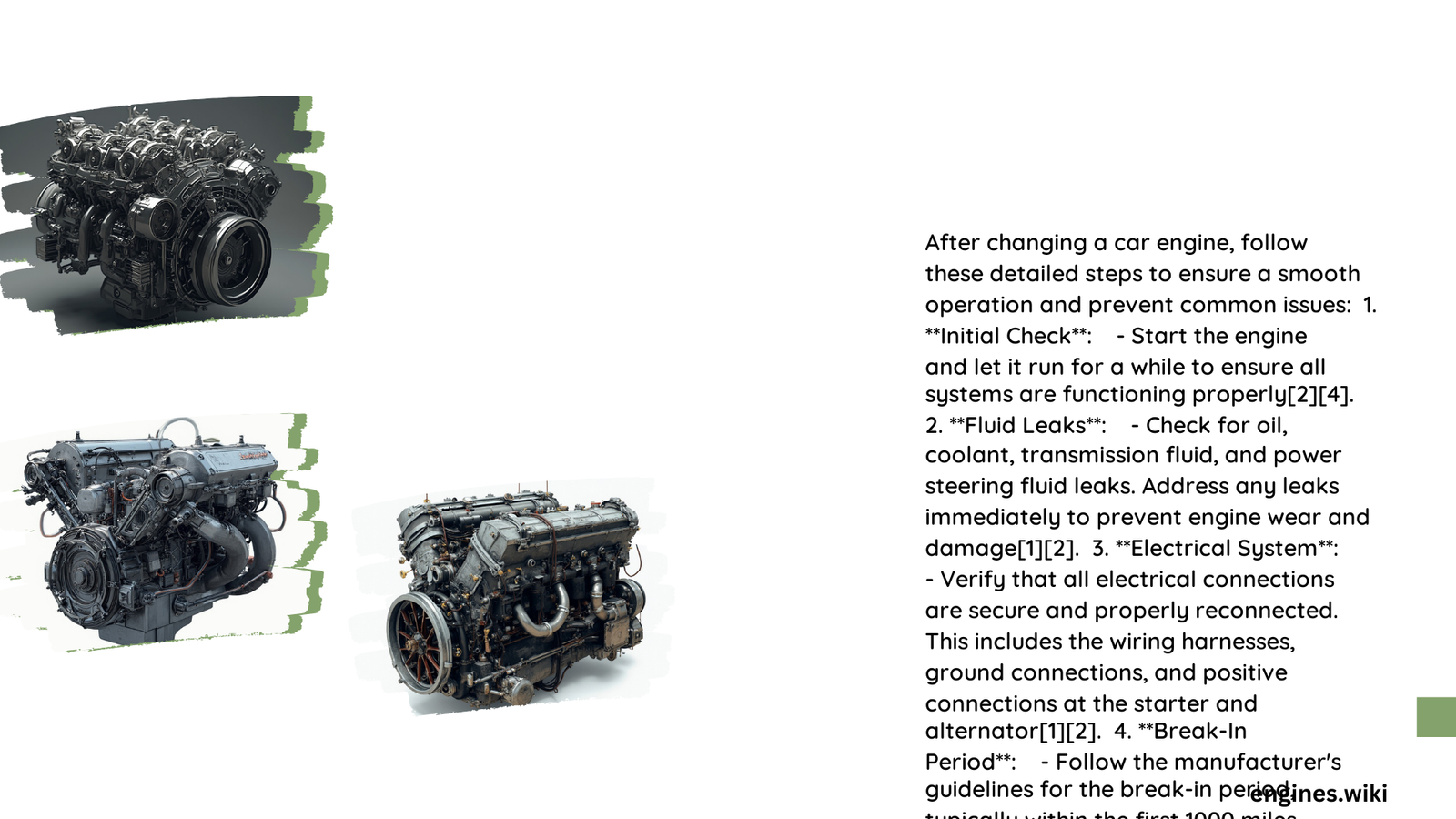Changing a car engine is a significant undertaking that requires careful attention to detail and proper follow-up procedures. After replacing your vehicle’s engine, it’s crucial to follow specific steps to ensure optimal performance, longevity, and safety. This comprehensive guide outlines the essential tasks and precautions to take after changing your car engine, including break-in procedures, fluid checks, ECU resets, and test drive parameters.
What Are the Key Steps After Engine Replacement?
- Follow proper engine break-in procedures
- Check and maintain fluid levels
- Reset the Engine Control Unit (ECU)
- Conduct a thorough test drive
- Monitor for any issues or error codes
Let’s delve into each of these steps in detail to ensure your newly installed engine performs at its best.
How to Properly Break In a New Engine?

Breaking in a new engine is crucial for its long-term performance and durability. Here’s a step-by-step guide to properly break in your newly installed engine:
What RPM Limits Should Be Observed?
- First Hour: Keep the engine below 2000 RPM, varying the speed constantly.
- Second Hour: Do not exceed 3000 RPM.
- Next 5 Hours: Stay under 4000 RPM.
- First 500-1000 Miles: Keep the engine below 4000 RPM and avoid the 3000-4000 RPM range for extended periods.
How to Vary Load Conditions?
- Alternate between acceleration and deceleration.
- Avoid using cruise control during the break-in period.
- Perform at least 10 cycles of accelerating from 20 to 50 MPH, followed by rapid deceleration.
What Specific Procedures Should Be Followed?
- Initial Start-Up:
- Run the engine at 1500-2500 RPM for 30 minutes.
-
Check oil pressure and look for fluid leaks.
-
Cooling System Management:
- Never add cold water to a hot engine.
-
Use hot water or antifreeze if needed.
- Change oil and filter after the first 10 hours of operation.
- Make any necessary engine adjustments.
Which Fluid Levels Need Checking After Engine Replacement?
Proper fluid levels are critical for your new engine’s performance. Here’s what you need to check:
| Fluid Type | Recommendations |
|---|---|
| Oil | Use conventional oil (0-30, 5-30, or 10-30) for break-in. Avoid synthetic initially. |
| Coolant | Use manufacturer-specified coolant. Maintain proper level. |
| Transmission Fluid | Use recommended type. Check and maintain proper level. |
How to Reset the Engine Control Unit (ECU)?
Resetting the ECU is crucial after engine replacement. Follow these steps:
- Gather Necessary Tools:
- Obtain a compatible scan tool or code reader.
-
Acquire any manufacturer-specific tools or software.
-
Clear Error Codes:
-
Use the scan tool to erase any existing error codes.
-
Reprogram or Reset ECU:
- Follow manufacturer instructions for ECU reset or reprogramming.
-
Update ECU software if required.
-
Verify Reset:
- Check for any new error codes post-reset.
What Parameters Should Be Observed During the Test Drive?
A proper test drive is essential to ensure your new engine is functioning correctly:
Distance and Speed Guidelines
- Drive for short periods (about an hour) initially.
- Vary speeds and avoid constant speed for long distances.
- Keep speed under 60 MPH for the first few hundred miles.
Performance Checks
- Engine Performance:
- Listen for unusual noises or vibrations.
-
Ensure smooth running and no overheating.
-
Transmission Function:
- Check for smooth gear shifts.
-
Verify proper gear engagement.
-
Cooling System:
- Monitor coolant temperature.
- Avoid engine overheating.
By following these detailed steps after changing your car engine, you can ensure optimal performance, longevity, and reliability of your newly installed powerplant. Remember to consult your vehicle’s manual and consider professional assistance for complex procedures.
References:
1. Break-In Procedures for Remanufactured Engines
2. Engine Break-In – Found the answer
3. Do You Need to Break in a New Engine?
